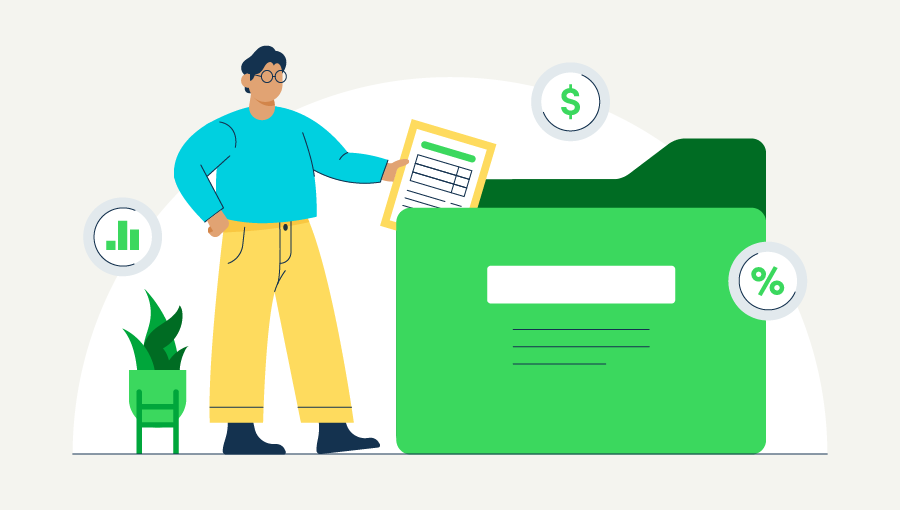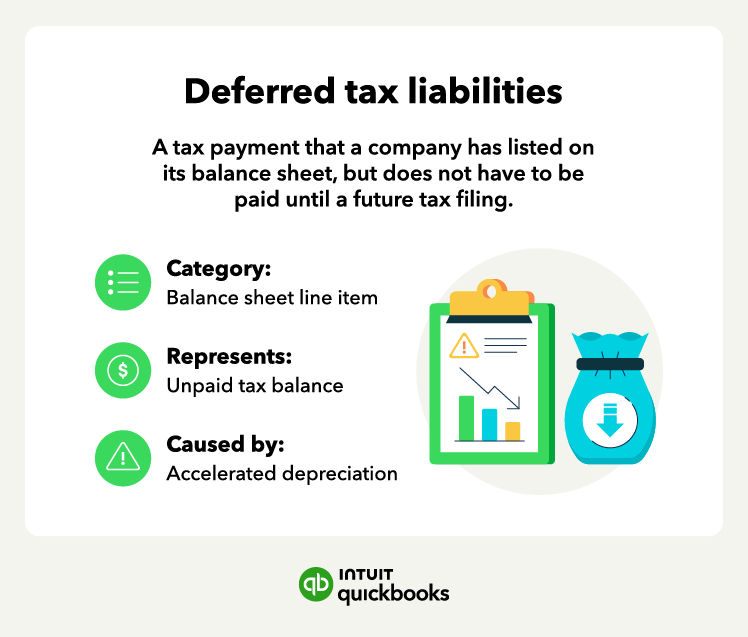
What are deferred tax assets and deferred tax liabilities?
Deferred tax assets vs. deferred tax liabilities
Deferred tax assets represent future tax benefits, while deferred tax liabilities are future tax obligations.
Tax regulations can determine which accounting system you’ll use for your business. For instance, you might anticipate receiving a payment, but you may not have to pay taxes on it in the current period—instead, you’ll pay it when the payment is physically received. These scenarios give rise to deferred tax assets and liabilities. It's crucial to recognize the difference between financial reporting and tax reporting when learning about deferral accounting.
Financial reporting involves accounting rules, such as those set forth by the Financial Accounting Standards Board (FASB). Financial statements report pre-tax net income, income tax expense, and net income after taxes. Tax reporting, on the other hand, calls for tax authorities to set the rules and regulations for preparing and filing tax returns. Tax authorities include the IRS and local state governments.
In this article, we’ll cover everything you need to know about deferred tax assets and liabilities to give you a much better understanding of what these terms mean and why they’re important.
Deferred tax asset vs. liability
A deferred tax asset means your future taxable income will be lower compared to financial accounting income, while a deferred tax liability means your future taxable income will be higher compared to your financial accounting income.
Some types of deferred tax assets, such as net operating losses, can provide a substantial tax break for small businesses. You can think of a deferred tax asset as lowering your taxes in advance, and deferred tax liability is like postponing a tax payment.
Is deferred tax an asset or a liability?
Deferred tax can be either an asset or a liability. Deferred tax liability represents taxes the business owes, and a deferred tax asset represents taxes that the business has overpaid.
What is a deferred tax asset?

A deferred tax asset (DTA) is an entry on a balance sheet that represents future decreases in taxable income relative to accounting income. For example, if your company has a net operating loss (NOL) that is carried forward to future income tax returns, that NOL will reduce taxable income in future years compared to financial accounting income. A DTA is valued according to the tax rates which will be in effect in those future years.
In 2017, Congress passed the Tax Cuts and Jobs Act, which reduced the corporate tax rate from 35% to a maximum of 21%. If a company had a NOL of $1 million, this would give rise to a deferred tax asset valued at $350,000 in 2017 at the old tax rate. But in 2018, when the new rate took effect, this deferred tax asset for the same $1 million NOL would be valued at only $210,000.
Here are a few questions to ask when learning about deferred tax assets:
- What type of asset is a deferred tax asset? A deferred tax asset is an intangible asset because it’s not a physical object, like equipment or buildings. It only exists on the balance sheet.
- Is a deferred tax asset a financial asset? A DTA is a financial asset that reduces future income tax expenses reported in the financial statements.
- Where are deferred tax assets listed on the balance sheet? They are listed on the balance sheet as “non-current assets.”
- When does a deferred tax asset have to be used? Deferred tax assets never expire but reverse when the timing difference between tax law and accounting rules ends.
Deferred tax assets represent potential future tax benefits resulting from temporary differences between taxable income and accounting income. Deferrals can be used to offset future tax liabilities.
Expert tip: While you can always carry deferred tax assets forward to future tax filings, they can’t be applied to tax filings in the past.
Examples of deferred tax assets
Deferred tax assets can come about for various reasons, such as net operating losses and bad debt. Here are a few key examples of deferred tax assets you may encounter:
- Net operating loss: The business incurred a financial loss for that period.
- Business expenses: When one accounting method recognizes certain expenses but the other doesn’t.
- Revenue: Instances where the business recognizes taxable income before that same revenue is recognized for financial accounting income.
- Bad debt: Before an unpaid debt is written off as uncollectible, it's reported as revenue. For tax purposes, companies write off bad debt only as debt becomes uncollectible, but for financial accounting, companies are allowed to estimate their future bad debt write-offs. The timing difference can create a deferred tax asset or a deferred tax liability.
What is a deferred tax liability?

A deferred tax liability (DTL) is a tax payment that a company has listed on its balance sheet but does not have to pay until a future tax filing. A payroll tax holiday is a type of deferred tax liability that allows businesses to put off paying their payroll taxes until a later date. The tax holiday represents a financial benefit to the company today but a liability to the company down the road.
Certain tax incentives will create a deferred tax liability journal entry, giving the business some temporary tax relief, but will be collected later. Depreciation expenses—like the annual devaluation of a fleet of company vehicles—can generate deferred tax liabilities.
Here are a few questions to ask when learning about deferred tax liabilities:
- Is deferred tax liability a debt? A deferred tax liability journal entry represents a tax payment that, due to timing differences in accounting processes, the payment can be postponed until a later date.
- Where are deferred tax liabilities listed on the balance sheet? They are listed on the balance sheet as “non-current liabilities.”
- Are deferred tax liabilities good or bad? A deferred tax liability is neutral or good, depending on your situation. It means you owe money, but don’t have to pay it right away. The downside is that your business needs to have money set aside in order to pay this debt off in the future.
Any temporary difference between the total amount of money you owe in taxes and the amount of taxes you have to pay in the current accounting cycle creates a deferred tax liability.
Deferred tax liability examples
There are two key deferred tax liabilities that you may come across. One is the depreciation of assets using accelerated depreciation and the other is an installment sale:
- Depreciation of assets: The IRS uses an accelerated asset depreciation model, which results in a difference between the company’s balance sheet value and the value of it for tax purposes. This is the most common example of a deferred tax liability.
- Installment sale: When a company collects payments for a product sold on an installment basis, the full value of that sale will be reported in the financial accounting income statement. However, the company only pays taxes on the annual installments. The company recognizes that it has a deferred tax liability for the timing difference between accounting income and tax income.
Evaluating deferred tax assets and liabilities
Determining when and if you can take advantage of a deferred tax asset can be tricky. The balance isn’t hidden because it’s reported in the financial statements. Analysts can take deferred tax balances into account, so there’s no distortion of the financial picture.
Example in context
Net operating loss carryforwards are a significant type of deferred tax. These occur when your business has a net loss but isn’t able to deduct all of the loss in the current year. The remaining balance of the loss is carried forward until you have a high enough net income to post the loss on a tax return.
But, of course, you can’t predict the future. You don’t know what years you’ll be eligible to use the carryforwards or whether you can use them all before the tax law prevents you from carrying the loss forward into future years.
Tax expense calculation
Understanding this equation can help you better understand your income statement. You’ll always want to consider the following equation when evaluating income tax deferrals:
Income tax expense = taxes payable + deferred tax liability – deferred tax asset
The income tax expense represents the sum of your business tax obligations, which is then disclosed on the income statement.
In contrast, the tax payable denotes the actual tax obligation based on the regulations of the tax code. This payable amount is acknowledged on the balance sheet as a liability until your business satisfies its tax due.
Should the tax expense surpass the tax liability, the surplus generates a deferred tax liability, necessitating future payment. On the other hand, if the tax payable exceeds the tax expense, the surplus forms a deferred tax asset and may serve as a resource for reducing future taxable income.
Questions to ask your accountant
If you have deferred tax assets and liabilities, there’s a good chance that lenders, investors, or potential buyers will want to know about them. Before you meet with essential stakeholders about financial matters, ask your accountant these questions:
- Of the netted figure on the balance sheet, what is the breakdown between deferred tax assets and deferred tax liabilities?
- What comprises the assets and liabilities? What events caused them?
- When do you expect the business to realize the tax assets and liabilities?
- How likely do you think it is that the business will be able to recognize the tax assets and liabilities? Is it inevitable, very likely, or only somewhat likely?
The FASB requires disclosure of deferred tax balances in the financial statements, found here.
Additional deferred tax assets and liabilities considerations
The revenue and expenses you report on your income statement don’t always translate into income and deductions for tax purposes. Tax accounting and financial accounting have slightly different rules, which is why your business’s taxable income is sometimes different from the net income on your financial statements.
Temporary vs. Permanent tax differences
Some of these instances result in permanent tax differences. For example, interest income from municipal bonds may be excluded from taxable income on the tax return, but included in accounting (book) income.
Other differences are temporary. These differences have to do with timing. You’ll end up recognizing the income and expenses eventually, but you just may realize them sooner under one system than you do under the other.
Temporary timing differences create deferred tax assets and liabilities. Deferred tax assets indicate that you’ve accumulated future tax deductions—in other words, a positive cash flow—while deferred tax liabilities indicate a future tax liability.
Accelerated asset depreciation
The IRS may allow a firm to use an accelerated method of depreciation, which generates more tax expense in the early years of an asset’s life and less expense in later years. The difference between depreciation expense in the accounting records and the tax return is due to the timing of the expense each year.
Accelerated asset depreciation is when a business takes a larger deduction on an asset in the first years of ownership and plans to take lower deductions as the asset ages. This can create a deferred tax asset since the business will be paying less in future taxes than if it used straight-line depreciation.
Streamline your accounting and save time
Learning the definitions and examples of deferred tax assets and deferred tax liabilities will help you better understand a balance sheet about these future tax credits or debits. To avoid tax filing errors related to these topics, use reliable accounting software and discuss any deferred tax balances with a tax preparer.
As a new small business owner, deferred tax assets and expenses are complex subjects that could easily confuse business owners and complicate matters in future periods.
If you would like to know more about how deferred assets and liabilities impact your small business, contact your trusted accountant or tax professional. Doing so will help ensure you follow proper accounting standards while receiving the maximum tax benefit.

Raine Guerrero is an experienced finance writer specializing in real estate investing, grant funding, and the cryptocurrency market. Raine enjoys making fintech topics digestible for readers—and primarily small business owners—across the globe.
